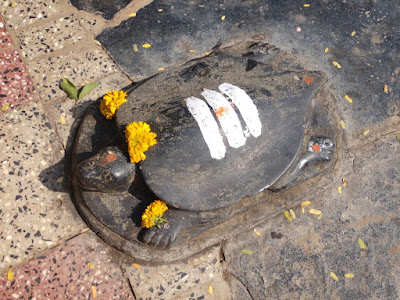Feb 16, 2022
The target of the day was Jaina temples of Vakkunda. I had reached Vakkunda by 8-15, parked my car at Madiwaleshwara Matha and walked towards the temples which are situated on a mound. However the mound was an island, it was surrounded by waters of river Malaprabha. Local people told me that coracles were available, the boatman needs to be found. I thanked them, not to take trouble, I can always come back after a month or two by when water level would have fallen, exposing the ground around the mound. I spent a while taking pictures of the island and the temples with my telephoto lens. It would've been interesting to go there while it was an island but no saying how long it take to find the boatman. Also the coracles weren't to be seen on the shore. Better to wait a few weeks and return. With that I left Vakkund and headed towards Bailhongal, mentally planning to see Rani Chennamma's tomb and Kalgudi.
Bailhongala was an important place in the XIX Century. During Rani Chennamma's time, it was under British control. In the battle of Oct 1824 between the armies of Kittur and British, Kittur army was defeated, Rani Chennamma was captured and imprisoned at Bailhongal fort, where she died in Feb 1829. Her mortal remains were buried at Bailhongal which is her memorial now.
I reached Chennamma's tomb around 9-30 AM. The memorial garden was undergoing major renovation work, it looked like a construction site. I took a look from outside and decided to skip it and come again when I come to Vakkund. I move on to Ramlingeshwar Devastana which is five minutes walk away.
The temple is said to be built originally by the Kadambas and renovated by the Chalukyas, probably during the X or XI Centuries. The temple has lost its original looks when it is altered in the process of repairs in recent times. The east-facing temple has three entrances- one each on its eastern, northern and southern sides. The main entrance i.e. the eastern one has semicircular steps. Normally Chalukyan temples have rectangular steps flanked by balustrades.
This is the southern side. The steps at the entrance are rectangular. It looks like the steps originally had balustrades, now they are bare. Despite the alterations, the temple is well maintained.
Moving to the rear of the temple. Thankfully the walls are still in original look. The rear most section is the Garbhagudi, the midsection is the Antharala and the front section is the Sabhamantapa. The temple's Shikhara is missing... unsure if the Shikhara was built at all.
Moving on to the northern side. On this side are two big slabs with Kannada inscriptions of Ratta dynasty dated 1086 CE.
The inscription slabs have been enclosed to protect it from rainwater, dust and vandals. Good work by whoever initiated it.
This is the best picture I could manage in the bright sunshine.
Sculpture of a tortoise in front of the main entrance.
This is the Sabhamantapa or Rangamantapa. The original pillars and beams have been retained. The roof and floor are concrete, cement and tiles. The pillars have been oil painted, that too a thick layer blurring the details of the pillars. Had there been any inscription on the pillars, the etchings would be filled up smoothly.
The temple see a constant flow of visitors through out the day, I think. A lady was attending to the visitors, offering them teertha & prasada. The lady said her family has been taking care of this temple for the past few decades.
It looks like the temple receives good financial support from the town's people. A heartfelt thanks to the supporters.
All around the Sabhamantapa is the Sukhanasi. The top slabs of the seating platform are original slabs.
This pillared hall can accommodate 70 to 80 people comfortably on the floor and another 20 on the platform. In the medieval times, meetings used to be held in temples. And temple was a place which pulled in cosmic energy which had a positive effect on a people seated inside. Probably the idea behind temple as a meeting venue was to have sound minds taking appropriate decisions.
A close look at one of the pillars. Such beautiful art covered in layers of paint. No! I told the lady that stones shouldn't be coated in lime or paint because of the adverse effect. Now. not much can be done. Try to remove the paint might damage the stone further.
On the seating platform, close to the southern entrance was this etching of traditional game called Huli-Mane which means home of the tiger. The game is played between two people, one representing the tiger and the other sheep. The objective of the tiger is to eat up the sheep and that of the sheep to escape. Etching of this grid can be seen in many temples and forts. Must've been a very popular game in those days.
I say Namaskara to the lady and leave. Back in the car, I was contemplating my next destination... any other nearby place or home. Home it would be. At Belawadi, I opted to take Uppinbetageri-Yadwad-Dharwad road. The route didn't have much traffic, probably I'll come cycling here one of the days.
.........

























No comments:
Post a Comment